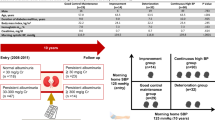Abstract
Diabetic nephropathy remains a leading cause of end-stage renal disease (ESRD) in western societies, accounting for about 40% of all patients beginning renal replacement therapy. Patients with type 2 diabetes comprise the largest and fastest growing single disease group requiring renal replacement therapy. In addition to the high risk of progression to ESRD, diabetic nephropathy is associated with a very high risk of cardiovascular (CV) morbidity and mortality, which is not abolished by dialysis or renal transplantation. Over the past two decades there have been major advances in our attempts to understand the risk factors for development and progression of diabetic renal dysfunction, that have resulted in better characterisation of the natural history of this serious complication. Effective antihypertensive treatment and aggressive management of CV risk factors have helped improve the prognosis of patients with overt diabetic nephropathy, particularly those with type 1 diabetes. However, for the larger proportion of patients with type 2 diabetes, the renal and CV prognoses are still poor. Recently, more focus has been placed on treating diabetic patients early in order to prevent future organ damage. Microalbuminuria is an important intermediary end-point that correlates strongly with CV mortality in all people with diabetes as well as progression to ESRD in people with type 1 diabetes. We can now identify patients at high risk early in the natural history of their disease. Clinical trials have uniformly shown that in the early disease history of diabetes, achievement of both tight glucose control, eg, HbA1c <7%, and tight blood pressure control eg, blood pressure <140/80 mm hg, substantially reduces cv events and progression of nephropathy. in latter stages of diabetes, tight blood pressure control has a relatively greater impact on cv risk reduction as compared to tight glucose control. the challenge for the practising physician, however, is to maximally utilise the available modalities of treatment to prevent progression to overt nephropathy and reduce the associated high risk of cv morbidity and mortality. in the early 21st century, the patient with type 2 diabetes will need to be the specific focus for use of these preventive treatment modalities due to the geometric risk in the international incidence of this disease.
This is a preview of subscription content, access via your institution
Access options
Subscribe to this journal
Receive 12 digital issues and online access to articles
$119.00 per year
only $9.92 per issue
Buy this article
- Purchase on Springer Link
- Instant access to full article PDF
Prices may be subject to local taxes which are calculated during checkout
Similar content being viewed by others
Author information
Authors and Affiliations
Corresponding author
Rights and permissions
About this article
Cite this article
Vora, J., Ibrahim, H. & Bakris, G. Responding to the challenge of diabetic nephropathy: the historic evolution of detection, prevention and management. J Hum Hypertens 14, 667–685 (2000). https://doi.org/10.1038/sj.jhh.1001058
Received:
Accepted:
Published:
Issue Date:
DOI: https://doi.org/10.1038/sj.jhh.1001058
Keywords
This article is cited by
-
Cost-effectiveness of switching to biphasic insulin aspart in poorly-controlled type 2 diabetes patients in China
Advances in Therapy (2008)
-
An economic evaluation of the Irbesartan in Diabetic Nephropathy Trial (IDNT) in a UK setting
Journal of Human Hypertension (2004)



